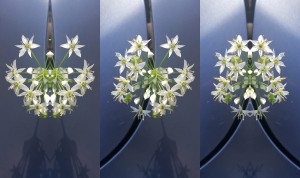I made a story about the steps involved in making a latte. The first photo is of the whole beans, then the ground beans in a portafilter, which is a device you insert into an espresso machine after you tamp the grounds. Then there’s a picture of a shot of espresso I pulled. It has a light crema, meaning that the pressure wasn’t very strong in the pull, but as you can tell from the roast of the beans (they’re really dark), the espresso will still be strong. The next picture is of the steamed milk. The large bubbles on top mean that the foam is dry and stiff, which generally means it’s over-steamed slightly, but you just have to swirl the milk some in order to get a more creamy consistency, if that’s what you desire. Many people actually prefer a stiffer foam. The last picture is the finished latte. There is a good balance between milk, foam, and espresso. This set of photos might seem rather useless, but it gives a good visual of the knowledge for espresso and how each component effects the others. There are a lot of factors to making a latte, and while it generally seems like a commodity, it’s actually rather amazing to see all the individual pieces separately and how much work goes into making one.
Lexi Hensley's Blog
Just another St. Edwards University Sites site
Category: Photography Class


I took photos of things in nature generally associated with symmetry: faces, flowers, butterflies, and leaves. Then I made them truly symmetrical and placed them side by side to show how sometimes making images symmetrical can make them look better, and sometimes it makes them look worse. I think I did a pretty good job of editing the photos, but now that I’m critiquing them, I notice some are in the wrong order (this is killing me now, actually, but I don’t have time to fix it) and the lighting discrepancies/ backgrounds change the way the images could be viewed. Other than that, I think the photos of the butterfly and the flower are really pretty, because of the contrast and the clarity of the images. I would definitely allow myself more time to edit the photos if I were to do this again in the future, because I took too much time adjusting the colors and being a perfectionist.
One of the main points I think Dr. Kennedy was trying to make during his presentation was that images can be warped by a title. You can, with 100% certainty, claim that a photograph means something, but if you are given one clue, or a different perspective about the image, your whole view of that image could change in an instant. Considering photographs are so convincing, and are often used as evidence that certain topics are true or false, this is a huge wicked problem because your reality and beliefs/perceptions could be altered without a second thought.
Seeing the way he changes images to make ordinary things transform into art was really amazing. Knowing that something so average could trigger such a deep response just by warping the colors or changing how the object appears is something that always intrigues me, as a photographer. There are certain questions that I have, though, about Dr. Kennedy’s photography. In his class, we learned about the moral limitations of photographers, or at least the code of ethics journalistic photographers generally have to follow. I’m curious if Dr. Kennedy has any photos that he regrets taking, or photos that could have been taken that he chose not to take, and how those photos (or potential photos) affected his career or views on photography. As a photographer, I have a difficult time judging when and if I can take photos, and I regret taking some, and I regret not taking some, so I would like to see his photos that he feels similarly about, and how they’ve changed his views about photography.
My group has decided so far to study the problem of traffic in Austin. One of the ways that my linked course (photography) could help with that is by taking pictures during certain times of the day or certain days of the week to show the current traffic patters throughout Austin. The photography class focuses on the power of photography, meaning that it could be a great source of intel or a bad one. One of the issues with photography is that it only captures a small portion of what the eye sees, but it’s very convincing. This means that someone could take a picture of 1-35 on a Friday afternoon and it looks completely clear, but right outside the line of the shot, there could be a pile-up of cars preventing traffic from getting through. With a catchy headline stating that traffic isn’t as bad as people think, many would believe that the traffic levels are actually a lot less than what others claim, but in reality, they can’t see what happened right outside the frame of the shot. While it seems that photography is solid proof of an incident, there is always something outside the frame of the photo that isn’t visible to the public, and that could create a biased view of reality that could effect how people view Austin.
© 2024 Lexi Hensley's Blog
Theme by Anders Noren — Up ↑




Recent Comments